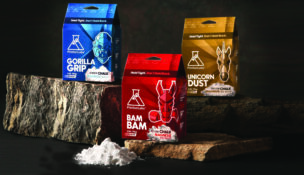A Colorado State of Wine
A Q&A with Infinite Monkey Theorem founder and winemaker Ben Parsons
Nicki McTague //February 21, 2019//


A Colorado State of Wine
A Q&A with Infinite Monkey Theorem founder and winemaker Ben Parsons
Nicki McTague //February 21, 2019//

The state of wine is changing for the better in Colorado.
In 2018, Wine Enthusiast magazine and Vogue magazine named Colorado’s Grand Valley American Viticulture Area (AVA) one of the “Ten Best Wine Getaways.” According to Doug Caskey, executive director of the Colorado Wine Industry Development Board, the annual economic impact of Colorado wine’s industry is $300 million, and the state currently holds more than 150 winery licenses. Colorado’s abundant sunshine coupled with low humidity and cooler temperatures make for gorgeous growing conditions, something grape growers have known for years but are only now having the opportunity to spotlight.
Ben Parsons, an Englishman who studied winemaking in Australia, launched his winery, The Infinite Monkey Theorem (IMT), at 9th and Santa Fe Drive in 2008. Parsons’ project put urban wineries on the map. After introducing canned wine to his lineup, Food & Wine magazine recognized him for making one of the “40 Wines That Change the Way We Drink.” We caught up with him at IMT’s full production facility in RiNo.
How have you seen the Colorado wine scene change over the past decade since you started IMT?
The wines have definitely become more consistent in terms of quality. That has a lot to do with more winemakers moving to the state and the knowledge they bring with them that is translating well to Colorado’s unique climate. Grape growers are also understanding their vineyard sites better and are making improvements year after year in terms of trellising, canopy and soil management.
Most importantly, Colorado wineries are beginning to work together to share information and ideas and to push the industry forward. In part, this dissemination of information is supported through the annual VinCo conference that is organized by the Colorado Association of Vintners and Enologists (CAVE), which attracts speakers from all over the wine world to talk on subjects from fermentation science to wine marketing.
What do you think the biggest misconception is about Colorado wine?
Most, but not all, consumers have preconceived ideas about Colorado wines, mostly using terms like bad, overpriced and sweet. Unfortunately, these impressions were made years ago, and it’s been difficult for the industry to shake them off. That being said, all developing wine regions go through awkward phases — look at Napa in the 70s or Oregon in the 80s. Back then, California restaurant wine lists were still dominated by predominantly French wines, and it took a few restaurateurs taking a risk on local California wines for them to become more universally accepted. The same is true in Colorado. We need local restaurants and stores to start touting locally produced wine to help raise awareness for the entire industry, which will in turn help to dispel these old misconceptions.
What are some of the challenges with producing wine in Colorado?
First, the elevation of 4,500 feet makes the growing season shorter (we have 165 days compared to Napa which has 200). That means that in some years, we can’t always ripen certain varietals like Cabernet Sauvignon or Mouvedre that ripen later. We also have high spring frost risk which can lead to reduced crop loads. Wind machines can help mitigate some of the frost risk, but a thorough analysis of vineyard site location is more likely to lead to more consistent harvests.
The other challenge is proximity. We aren’t close to California, so if a piece of harvest/crush equipment breaks, we can’t simply call the technician out to fix it. We have to determine what is wrong and then fix it ourselves. Over the years, it means we’ve become pretty adept at maintaining our equipment and prolonging its life.
What do you love about producing wine in Colorado?
It’s a frontier winemaking state with unique challenges. If it was easy, it wouldn’t be any fun, so I think we all embrace the challenges and thrive from them. Colorado is also fairly unique in that 85 percent of the population lives on the Front Range, which has really assisted the boom of wineries that have chosen to locate along the urban corridor. With the majority of people, restaurants and wine stores located in the city, we have a larger customer base and don’t have to rely on a steady flow of tourists during the growing season who aren’t necessarily repeat customers.
Where do you see the industry ten years from now? How do you think we get there?
I think the wines will continue to garner high ratings in national magazines, and I hope that together, as an industry, we see increased support from the Colorado restaurant community. Restaurants and by-the-glass placements are critical to introduce Colorado wines to the masses. Without their support, it will be an uphill struggle. This is one of the reasons I’m putting on events like a Colorado wine seminar with Ashley Hausman (MW) to raise awareness of Colorado wines and to encourage wine buyers to support local wines. Our goal is to really explain to buyers and others in the restaurant industries what makes Colorado such a unique place to grow grapes while introducing them to a great selection of excellent wines from producers all over the state — from the Grand Valley in Palisade to West Elks to the Four Corners.
About Nicki McTague: Nicki McTague is VP of Corporate Operations for The Infinite Monkey Theorem. McTague has worked at the Infinite Monkey Theorem for five years and in her role, facilitates business development including vision, goals and objectives for IMT and oversees and supports community engagement.

























